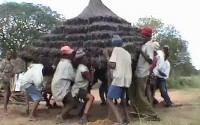In this project anthropological and linguistic expertise is brought together in an interdisciplinary research team working towards an in-depth, thorough description, documentation and multi-media compilation of linguistic and cultural materials for ≠Akhoe Hai//om. Between 2003 and 2006 field research for this project is carried out in Namibia in conjunction with speakers of the ≠Akhoe Hai//om community as well as with teachers from local schools and with WIMSA (the Working Group of Indigenous Minorities in Southern Africa).
≠Akhoe Hai//om cultural features rely to a large extent on language. Therefore the local cultural profile is not only under the threat of being replaced by practices of neighbouring groups, it is also under the threat of simply falling into disuse or of fundamentally changing its character as a consequence of a more general threat to the language itself.
For example the project aims to capture the language of kin-talk and naming and thereby to encourage ≠Akhoe Hai//om to try to establish social relations on their terms (literally) as a means of empowering this marginalized group of people. The project also aims to document healing dance events in their communicative dynamics, that is by recording in detail how numerous individual contributions and turn taking produce the overall healing dance. Healing dances are a central part of the Khoisan cultural heritage. In the ≠Akhoe Hai//om case, healing trance dances are still carried out regularly (3-4 times a month) and they are conducted as a group effort involving men, women and children who sing and dance. But in Namibia and Botswana there is a tendency towards commercialization and individual appropriation of what up to recently was a shared common resource. By creating a record for the community of ≠Akhoe Hai//om speakers of an open and essentially egalitarian and cooperative event the project aims to facilitate the use of cultural and linguistic resources for local purposes and to prevent “pirating” to take place.
With schooling and integration into the national culture of Namibia other features of ≠Akhoe Hai//om daily life, such as their landscape terminology that contributes to their outstanding orientation skills or their lunar calendar and a counting system based on body parts are being marginalized and may disappear altogether. The project aims to document these cultural features while they can still be recorded in practice and before they become mere “memory culture” and are thereby changed in nature and function.




